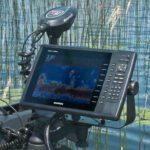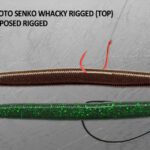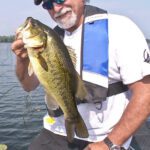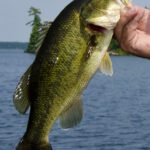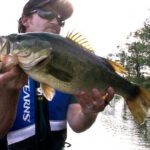Hardcore Largemouth Bass anglers tend to be a pretty focused and enthusiastic group. Opening day for them is like Christmas morning for kids—complete with all the toys! In a typical Bass boat, you’re likely to see rod and reel combos that could include six flippin’ sticks, five pitchin’ poles, and four wormin’ rods, each rigged with its own specific bait. So there’s no time lost presenting that Bass with a smorgasbord of delectable appetizers. These “fish heads” know pretty much everything about ol’ bucket-mouth, including their need for tight cover, be it under logs, trees, docks, weeds, reeds or lily pads. Getting them outta there, though? That’s a different story. Hence all the different gear.
BUCKET-MOUTHED POWERHOUSES
Today we’re going to try something that will hopefully appeal to anglers who aren’t so specific about their fish, and show them what a blast they can have fishing these bucket-mouthed powerhouses in the junk—with medium spinning rods and reels, light braided line and soft stick-baits.
As always, our KLP (Knowledge, Location, Presentation) formula for fishing success played a big role in this show’s outcome. Thanks to the solunar tables, we already knew the major and minor activity periods today with both sun and moon sharing the sky for about six hours. Couple this with relatively bright skies, a slight breeze, and water temperatures in the mid-seventies, and we’ve put ourselves into the potential for Bass-a-geddon!
With all this knowledge, we know the types of areas these little dynamos will be hiding out. So we grabbed our GPS maps and looked for shallow bays with lots of cover, much like their springtime spawning bays. Our first stop was Wigwam Bay, where we shot a show last year with Steve Niedzwiecki, the owner of Chaudiere Lodge and an outstanding guide.
THE PRESENTATIONS
The presentations were very simple for this episode: Pete would use a Senko rigged “Texposed style”—a variation of the Texas rig with the tip of the hook just slightly buried in the worm, making it weedless but easy to penetrate the fish on the hookset. Angelo would be using a weedless “wacky rig”, where the hook goes through the worm midpoint, causing it to swim horizontally off either side of the hook.
The Senko brand stick-baits that the boys used on the show are actually quite special. They’re infused with eleven proprietary ingredients (primarily amino acids) and specifically weighted with salt. To humans, they smell like plastic. But to the fish, the combination of these amino acids creates a pheromone-like taste and smell, drawing the fish instinctively to it. The salt ballast gives the bait an incredibly natural action on the vertical drop, which the fish find irresistible. But as the salt dissolves, the plastic actually becomes softer, which makes the fish want to hold on to it longer, creating a better chance to hook up.
ONE FISH, ONE BAIT
A trick you can use to get irresistible movement when wacky-rigging soft stick-baits—and also help prevent those “one fish, one bait” outcomes that are so typical with these fragile baits—is to try a rubber ‘O’ ring slightly smaller than the diameter of the bait. Using either a special ‘O’ ring tool or simply your fingers, slide it in place about halfway down the worm body, then place the hook between the bait and the ring. With this technique, the Senko has more freedom of movement and you’re not putting a hole in the worm (which creates a weak point, usually causing it to break and fall off when old bucket-mouth hits it).
THE 90% RULE
Spinning gear makes for easy casting, just be sure you use the 90% rule: If you make a fifty-foot cast to your target, let the bait drop vertically, lift it, and do it again over a maximum of ten feet, then retrieve and cast again. 10% fishing, 90% casting and retrieving.
In this episode, we were fishing pencil reeds with lily pads, and it didn’t seem to matter how big or small the patches of pads were. This combo is a surefire pattern that’s especially effective under mile-high bluebird skies. Throw in a bit of a breeze and you’ve got a bass outing made in heaven.
When fishing big vast areas like reed beds, it’s always good to have a couple rods rigged up. If the cover looks extra heavy but the bottom is relatively clean, then often a jig-and-pig is a more practical bait than a stick-bait. Always have a backup.
BAD NEWS AND GOOD NEWS
On the French River, Largemouth Bass are not the dominant predator that they are in a lot of waters farther south. Up there, they definitely take a back seat to toothy monsters like muskie, Pike, Walleye, and even their cousins the Smallmouth Bass. The bad news is that most of the French lacks the type of cover and forage that’s conducive to a strong, healthy Largemouth population. The good news is that most of the French lacks the type of cover and forage that’s conducive to a strong healthy Largemouth population… So when you do find that sweet spot like we have here, the greenback is King!
When Largemouth use overhead cover like pad patches or high growing weeds, they use their senses of hearing, sight, vibration, and smell to annihilate prey. Aside from muskie and larger Pike, Largemouth Bass are the apex predators in Wigwam bay—and they do it quite well.
THE BOTTOM LINE
All but one of the fish in this episode were taken on un-weighted soft stick-baits. The reason we used them is simple: The slow descent of the drop cannot be copied by any other style of bait out there. Normally the heavier the bait, the quicker it plummets into the thick carpet of weeds on the bottom where it can’t be seen by a Bass. These fish are seeing our baits for an extended amount of time and crushing them before they even get near the weeds.
As true lovers of Largemouth Bass fishing, we had a riot on this outing. We approached the situation with light gear, took their chances on being able to muscle in these feisty predators, went through about fifty baits, but caught a great sack of fish in the process.
Bottom line: You don’t need all the fancy, expensive, super heavy-duty rods and reels to catch largies in the junk. Take your spinning rig, load it with braid, grab half a dozen bags of soft stick-baits and have at it!





